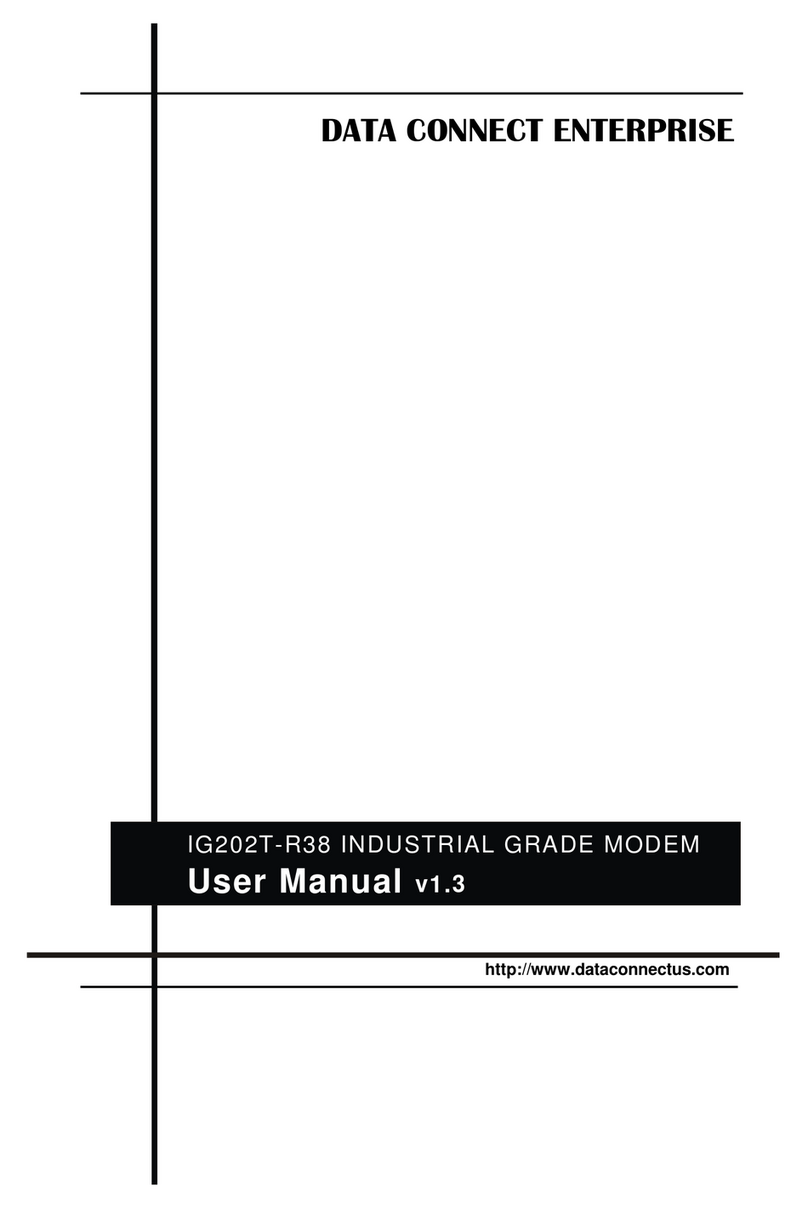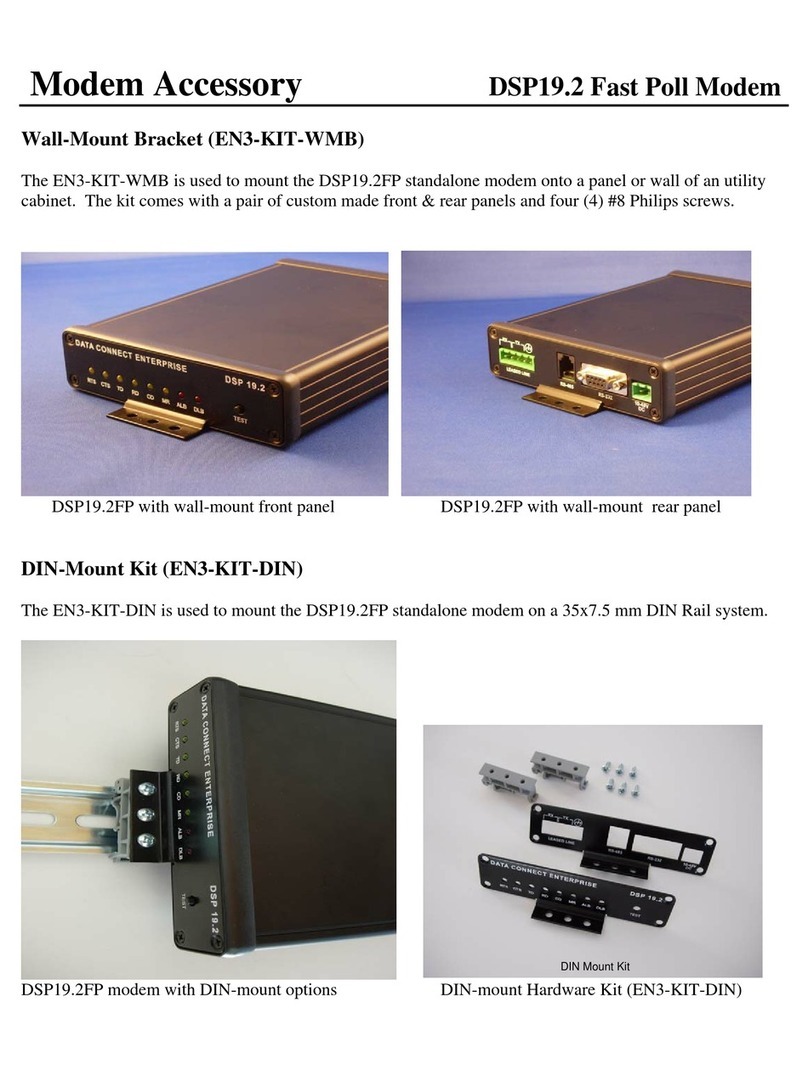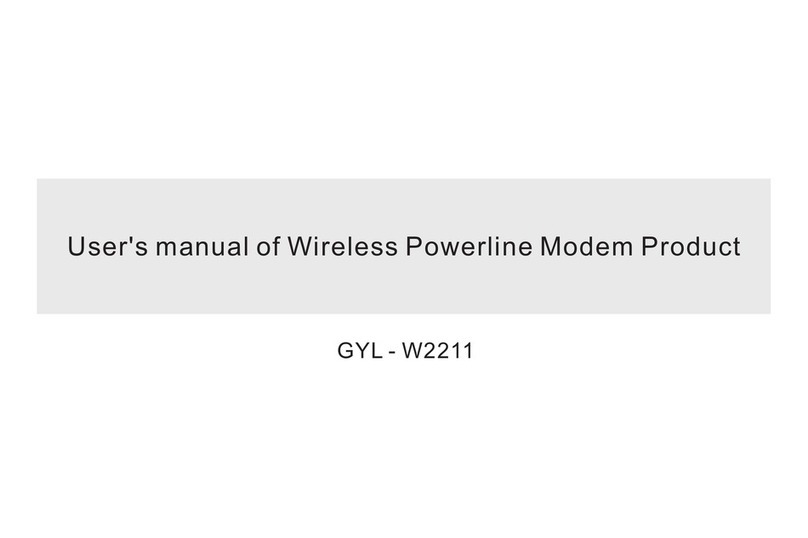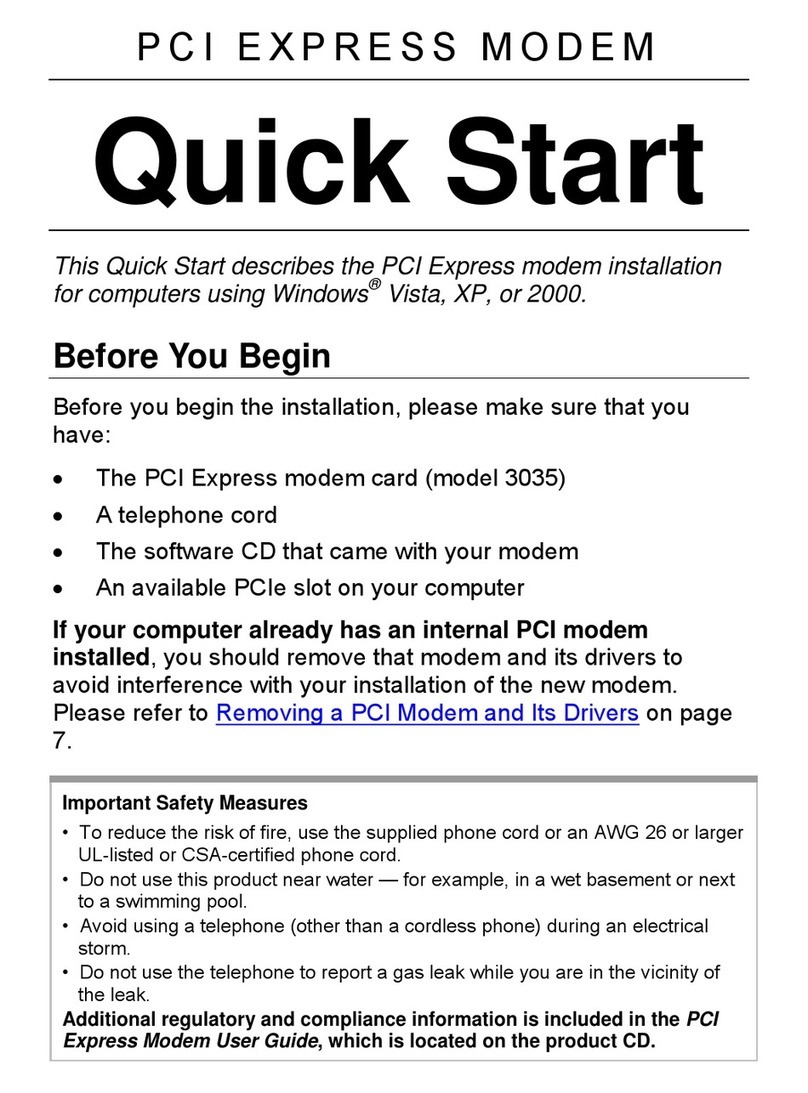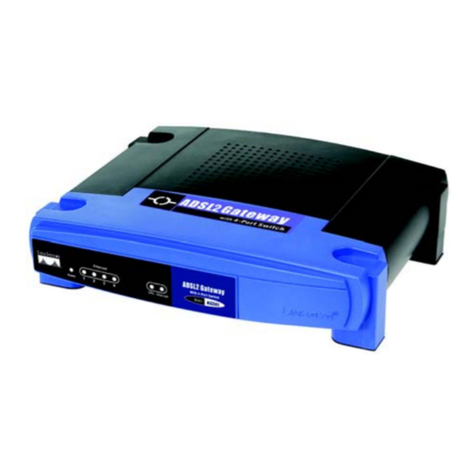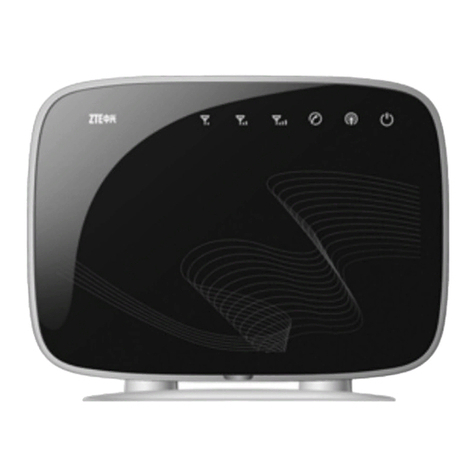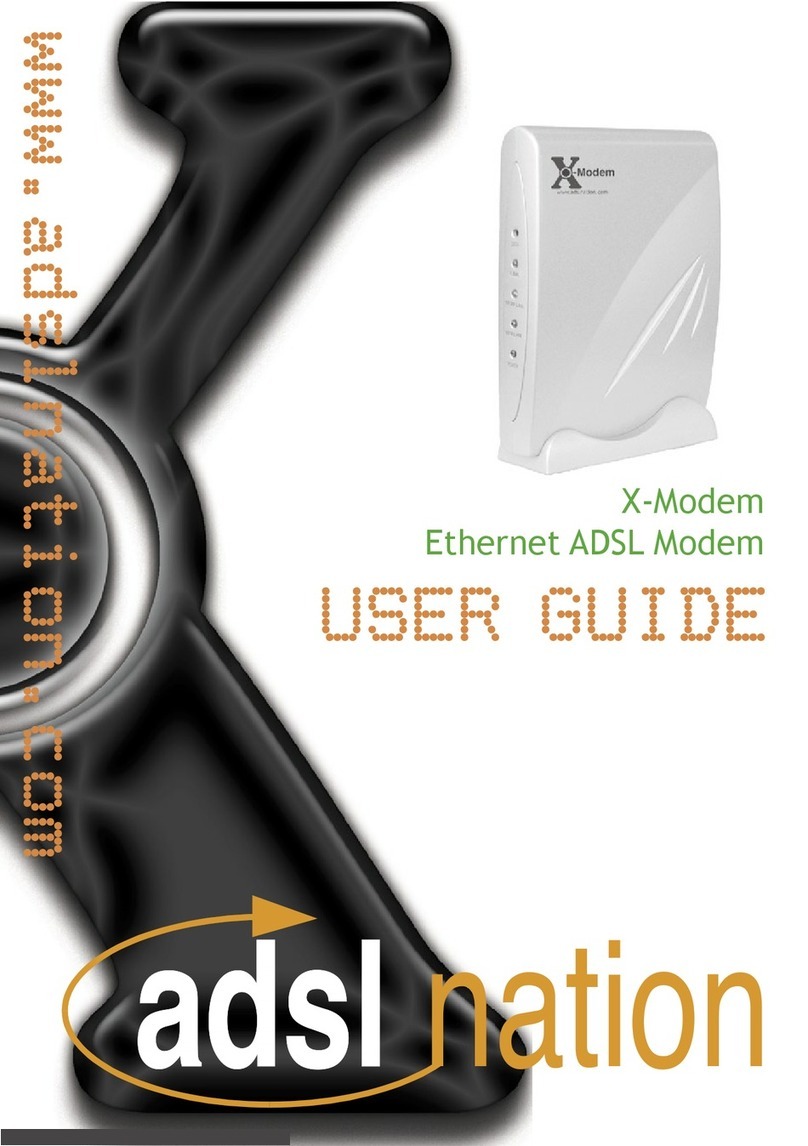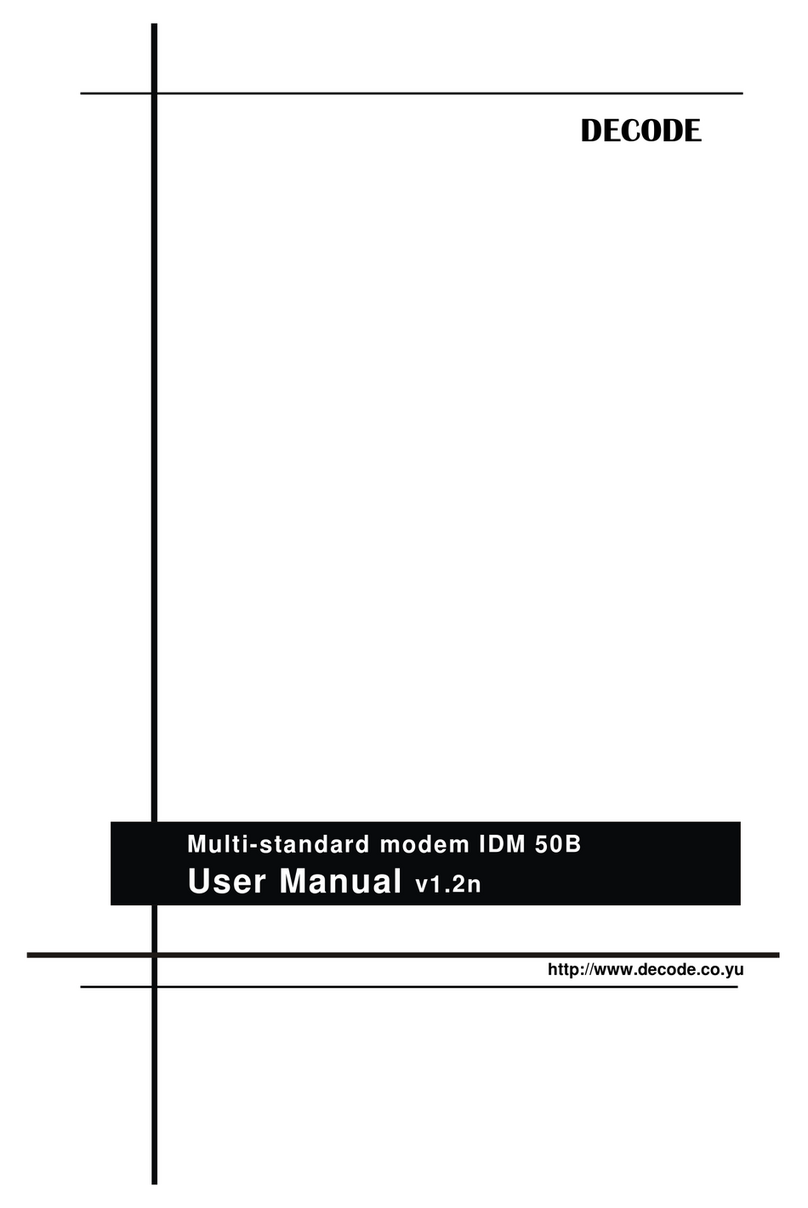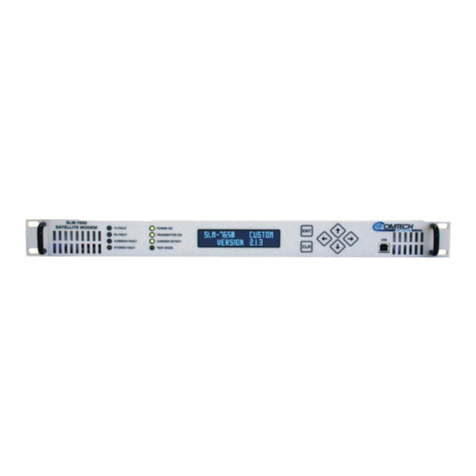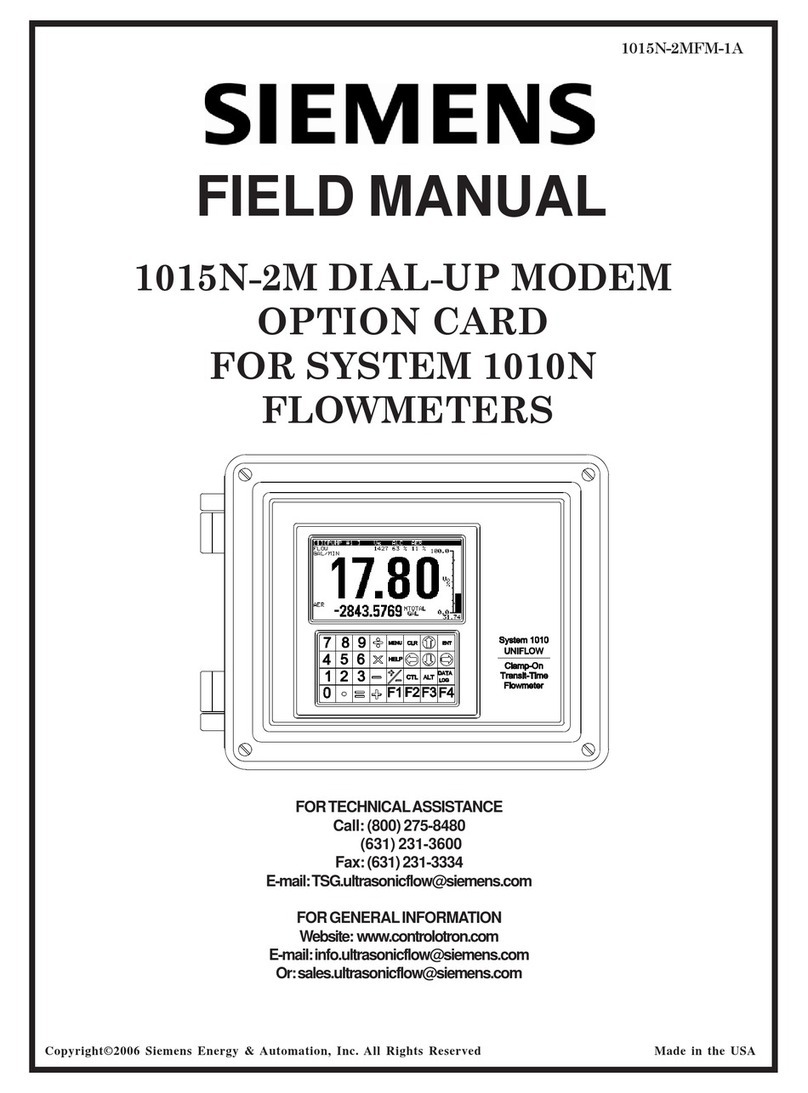Data Connect IG202T User manual

DATA CONNECT ENTERPRISE
User’s Manual
IG202T and IGV23 Modem
Document Number 520-01005-001 Rev. A

DATA CONNECT
iii User’s Manual - SM202T/SMV23 Modem
Contents
Contents .................................................................................................................. iii
Figures..................................................................................................................... iv
Chapter 1 Introduction ............................................................................................ 5
Features ......................................................................................................................6
Applications ................................................................................................................. 7
Chapter 2 Installation .............................................................................................. 8
Unpacking Your Hardware ..........................................................................................8
Additional Items You Need to Complete Your Installation........................................... 8
Hardware Overview.....................................................................................................9
Front View ...................................................................................................................9
Back View....................................................................................................................9
Rack-Mount View ......................................................................................................10
Installation Summary.................................................................................................10
Configuring the Modem .............................................................................................11
Setting the DIP Switches...........................................................................................13
SW1-1 Auto RTS .............................................................................................. 14
SW1-2 RTS-CTS Delay (Bell 202 Mode Only) ................................................. 14
SW1-3 Transmit Carrier Control .......................................................................14
SW1-4 – Soft Carrier Control............................................................................... 15
SW1-5 Anti-streaming ...................................................................................... 15
SW1-6 2-Wire or 4-Wire Operation ..................................................................15
SW1-7 Transmitter Termination Impedance..................................................... 15
SW1-8 Receiver Termination Impedance......................................................... 16
JP1 Transmit Level...........................................................................................16
JP2 RS-232 or RS-485 Serial Interface (Standalone Only)............................. 17
For Rack-Mount Plug-in Modules ........................................................................ 17
Connecting to a Transmission Line ........................................................................... 18
Connecting to a Voltage Source................................................................................ 19
Connecting to an RS-232 Device .............................................................................. 20
Connecting to an RS-485 Device .............................................................................. 20
LEDs.......................................................................................................................... 21
Loopback Control Switch...........................................................................................21
Problem Solving ........................................................................................................23

Contents
iv User’s Manual - SM202T/SMV23 Modem
Figures
Figure 1-1. Point-to-Point Network Using the IG202T/V23 Modem ........................................7
Figure 1-2. Multipoint Polling Network Using the IG202T/V23 Modem................................... 7
Figure 2-1. Front View of the IG202T/V23 Modem .................................................................9
Figure 2-2. Back View of IG202T Modem .............................................................................10
Figure 2-3. Rack-Mount Module for the IG202T-RM Modem Board .....................................10
Figure 2-4. IG202T & IGV23 Stand-alone Modem Board .....................................................12
Figure 2-5. IG202T & IGV23 -mount Modem Board .............................................................13
Figure 2-7. Pin Locations on the Modem’s RJ-11C Jack ......................................................20
Figure 2-8. Loopback Diagnostic Modes...............................................................................22
Figure 2-9. Back-to-Back Connection to a Second Modem ..................................................25

DATA CONNECT ENTERPRISE
5 User’s Manual - SM202T/SMV23 Modem
Chapter 1
Introduction
Thank you for purchasing Data Connect IG202T and IGV23 leased line modem,
the finest industrial-grade modem available. This manual will cover both the standalone
IG202T, a Bell 202 compatible, and the standalone IGV23, an ITU-V23 compatible modems.
The Data Connect IG202T/V23 modem is a 0 to1200 bps modem designed for 4-
wire, full-duplex or 2-wire, half-duplex operation over a voice-band leased line or private line.
The modem is designed utilizing the stand FSK modulation technology to achieve high
performance and low cost.
The IG202T/V23 modem is ideally suited for multi-point communication systems that require
fast response time, short training time, and low throughput delay.
This User’s Guide describes the IG202T/V23 (AC-powered) and IG202T-DC/V23-DC (DC-
powered) stand-alone modems, as well as the rack-mount IG202T-RM plug-in module for
the Motorola/UDS RM16M. This manual is designed to get your modem “up and running” as
quickly as possible. It contains all the information you need to configure and install your
modem. It also contains troubleshooting information in the unlikely event you encounter a
problem with your modem.

Introduction
6 User’s Manual - SM202T/SMV23 Modem
Features
The IG202T/V23 modem is specifically designed for harsh environments typically associated
in utility substations and industrial facilities. Though functionally similar to commercial
modems, the IG202T/V23 provides the following unique features that make it well suited for
utility and industrial applications.
yPackaged in a rugged, compact enclosure for industrial applications.
yLeased-line interface protected with heavy-duty surge protection devices.
yBuilt-in hardware watchdog timer for software lock-up prevention without
requiring human intervention, making it ideal for unmanned locations.
yWorks within an extended temperature range of -40ºC to +85ºC.
yDesigned with coupling transformers for high-voltage isolation and common
mode noise rejection in industrial and commercial environments.
yOperate over voice-band conditioned or unconditioned leased-line and pilot
wires.
yAccepts power from a wide range of AC and DC power supplies:
– IG202T/V23: 90 to 265 VAC or 100 to 400 VDC
– IG202T/V23-DC: 10 to 60 VDC
– IG202T/V23-RM: Plug-in module for the Motorola/UDS RM16M modem nest
yStandard industrial connectors for data, analog, and power interfaces allow
reliable interconnection to other industrial equipment.
yAsynchronous data rates 0-1200 bps.
yEasily accessible DIP switches for user configuration and option selection.
yDB9-F connector for RS-232/V.24 interface, and RJ-11 for RS-485.
yLocal analog, local digital, and remote digital loopback diagnostics.

Introduction
7 User’s Manual - SM202T/SMV23 Modem
Applications
The IG202T/V23 modem is designed for point-to-point and multipoint data communications.
Figure 1-1 shows a typical point-to-point configuration using the IG202T modem and Figure
1-2 shows a typical multipoint configuration using the IG202T modem.
Workstation
Modem Modem
Remote Terminal
Figure 1-1. Point-to-Point Network Using the IG202T/V23 Modem
Workstation
Modem
Modem
Modem
Modem
Modem
Modem
Remote Terminal
Remote Terminal
Figure 1-2. Multipoint Polling Network Using the IG202T/V23 Modem
There are a number of factors that can affect the modem’s operation and performance.
These include:
yModem speed (i.e. bit error rate, transmission line distance)
y2-wire or 4-wire configuration
yTransmission line characteristics, noise, and line impairments
yTransmission cable length (pilot wire)
yNetwork configuration (point-to-point or multipoint)

DATA CONNECT ENTERPRISE
8 User’s Manual - SM202T/SMV23 Modem
Chapter 2
Installation
This chapter describes how to configure and install the modem to maximize the performance
and to match with your Data Terminal Equipment (DTE) or Remote Terminal Unit (RTU).
Unpacking Your Hardware
Your package should include:
yAt least one of the following IG202T or IGV23 modems:
– Model IG202T or IGV23 for 90 to 265 VAC or 100 to 400 VDC
–Model IG202T-DC or IGV23-DC for 10 to 60 VDC
– Model IG202T-RM or IGV23-RM for RM16M plug-in module
yA switching power supply module for 90-265VAC input (model IG202T or IGV23
only)
yA leased-line cable with optional earth ground conductor (for stand-alone units
only)
yA DC power cable (model IG202T-DC or IGV23 modem only)
yThis User’s Manual or CD-ROM
If your package contents are damaged or missing, contact your place of purchase.
Additional Items You Need to Complete Your Installation
To complete your installation and operate your modem, you need these additional items:
yTwo- or four-wire transmission line or leased line
yA DB-9 data cable for your RS-232 interface Data Terminal Equipment (DTE)
port, or a RJ-11C data cable for your RS-485 DTE.
yPower supply that provides either:
– 90 to 265 Volts AC, 50 to 60 Hz, single phase or 100 to 400 VDC (if you have
the model IG202T/V23 modem), or
– 10 to 60 Volts DC (if you have the model IG202T-DC modem)

Installation
9 User’s Manual - SM202T/SMV23 Modem
– For the IG202T-RM, consult the documentation for your Motorola/UDS
RM16M
Hardware Overview
Front View
Figure 2-1 shows the front view of the IG202T/V23 stand-alone modem. Starting from the
left side, this view shows:
yA set of eight LEDs for modem interface status (see Table 2-4 on page 21)
yA loopback control push-button switch (see Loopback Control Switch on page 21)
Figure 2-1. Front View of the IG202T/V23 Modem
Back View
Figure 2-2 shows the back view of the IG202T stand-alone modem. Starting from the left
side, this view shows:
yA 4-wire/2-wire configuration block labeled LEASED LINE
yAn RJ-11 modular jack labeled RS-485 for connecting the modem to an RS-485
RTU
yA female, 9-pin RS-232 connector labeled RS-232 for connecting the modem to a
standard DTE (RTU)
yA power connector labeled 10-48V DC

Installation
10 User’s Manual - SM202T/SMV23 Modem
Figure 2-2. Back View of IG202T Modem
Rack-Mount View
Figure 2-3 shows the rack-mount plug-in module.
Figure 2-3. Rack-Mount Module for the IG202T-RM Modem Board
Installation Summary
This section describes the steps for installing the modem.

Installation
11 User’s Manual - SM202T/SMV23 Modem
NOTE: It is important to follow the steps below to configure the modem’s DIP
switches to match your DTE/RTU interface requirement and the transmission
line characteristics. If you are not certain about your system’s parameters or
the leased-line configuration, please contact your network administrator for
assistance.
1. Configure the modem using the DIP switches and jumpers. See pages 13 .
2. Connect to a transmission line. See page 18.
3. Connect to a voltage source. See page 19.
4. Connect a DTE device. See page 20.
Configuring the Modem
You configure the modem using the 8-position DIP switch and two sets of configuration
jumpers on the printed circuit board of the modem labeled S1,JP1 and JP2.
Configuration DIP switches S1 for the stand-alone and rack-mount modems are identical.
Their descriptions in this user’s manual apply to both modem versions. Configuration jumper
JP1 for the standalone and rack-mount modem card is used to select transmit output level.
It is important to follow the steps described below, in the order shown, to ensure that you
configure your modem properly using the modem DIP switches:
1. Use DIP switch 1 (S1) to configure the modem for your host DTE interface and
network topology. Using S1, you select the modem’s serial port to match your
host computer or RTU devices, and other DTE specific operating parameters.
2. Use Jumper (JP1) to select the modem’s transmitter output level to match your
specific leased line conditions. The JP2 is used only in the standalone modem for
selecting either RS-232 or RS-485 interface.
3. After you change the DIP switch settings, recycle power to the modem to have
the settings take effect.
NOTE: The DIP switch settings will not take effect until you recycle power to the
modem.
To access the configuration DIP switches and jumpers on the stand-alone modem:
1. Ground yourself to discharge any ESD, which might cause damage to the
sensitive devices on the modem board.
2. Use a small Philips screw driver to remove the two screws at the bottom of the
enclosure and remove the top cover. The location of the DIP switches and
jumpers for the stand-alone modem are shown in Figure 2-4. For DIP switches
and jumpers on the rack-mount plug-in module, see Figure 2-5.

Installation
12 User’s Manual - SM202T/SMV23 Modem
3. Replace the top cover after the configuration is completed.
D7 D8 D9 D10 D11 D12 D13
J4
J2
J3 J1
T2
T1
U2
1
SW1
U5
D14
S3
U1
Configuration Switch
(SW1)
Configuration Jumpers
JP1 & JP2
JP1
2
78
1
JP2
1
5
2
6
8
OFF
Figure 2-4. IG202T & IGV23 Stand-alone Modem Board

Installation
13 User’s Manual - SM202T/SMV23 Modem
J1
U19
T2
T1
U15
U5
GT2 GT1
S3
Y2
U18
U17
D11 D10
Y1
F1
F2
F3
F4
U15
U1
Data Rate 1
Data Rate 2
Data Rate 3
Char Length
Auto RTS
Tx Carrier
4W/2W
Tx Impedance
RDLB Dis able
Factoryonly
TxLevel1
TxLevel2
TxLevel3
RcvRange
TxEqualizer
RxEqualizer
Anti-Stream
RTS-CTSDelay
Option1
Option2
D2 D1D3D4D5D6D7D8D9
U3
U8
U10
U6
U12
GT4 GT3
U2 U4
D27 D25
E1
E2
E3
J2
12
13 14
U7 U9
U22
U14
11 10 10
S1 S2
U21
31
JP1
600 ohmHigh-Z
Configuration Jumper
for Receiver Termination
Configuration DIP Switches
Figure 2-5. IG202T & IGV23 -mount Modem Board
Setting the DIP Switches
SW1 is a 8-position DIP switches used to configure all the options and features of the
modem. Table 2-3 shows the setting of the switches.
NOTE: Switches SW1 are toggle switches. To configure the switches, use a small
sharp pin to firmly press down on one end to open or to close each switch.
Never leave any switch in half open and half close. Press down on the side of
the switch labeled OPEN is referring to as OFF condition. When the switch is
CLOSED, it is in the ON state.
Table 2-1. Modem Switch Settings
Switch Settings
DIP Switches
ON OFF (Default)
DIP Switch S1
SW1-1: Auto RTS Enable Disable
SW1-2: RTS-CTS Delay (Bell 202 mode only) 33 ms 10.0 ms (Bell 202T)
33 ms (V.23 mode)
SW1-3: Transmit Carrier Control Constant ON Controlled by RTS
SW1-4: Soft Carrier (Bell 202 mode only) Enable Disable
SW1-5: Anti-streaming Enable (30 seconds) Disable
SW1-6: 2- or 4-wire leased line 2-wire half duplex 4-wire full duplex
SW1-7: Transmitter Termination Controlled by RTS 600 ohms
SW1-8: Receiver Termination 600 ohms High (approx 20K)

Installation
14 User’s Manual - SM202T/SMV23 Modem
SW1-1 Auto RTS
ySW1-1 ON = Enable Auto RTS
ySW1-1 OFF = Disable Auto RTS (default)
For data terminals that do not provide hardware Request To Send (RTS), set switch SW1-1
to ON to enable auto RTS mode. In this mode, TXD is detected at the modem and an
internal RTS signal is turned ON. After training completes, the TXD is transmitted to the
remote modem. The transmitter turns itself off if no TXD is detected after a pre-determined
length of idle time.
SW1-2 RTS-CTS Delay (Bell 202 Mode Only)
ySW1-2 ON = 33.0 ms delay
ySW1-2 OFF = 10.0 ms delay (default)
Switches SW1-2 determines the duration of the RTS-CTS delay in Bell 202 mode. For V23
mode, the RTS-CTS delay is fixed at 33 ms.
SW1-3 Transmit Carrier Control
ySW1-3 ON = Constant carrier
ySW1-3 OFF = Controlled by RTS (default)
Switch SW1-3 selects either constant or switched carrier. Constant carrier allows DTEs,
such as asynchronous terminals or RTUs, to operate with modems, without requiring an
input RTS signal. If you enable constant carrier (switch SW1-3 = ON), the modem forces the
transmit carrier active and the RTS-CTS delay is shortened to less than 0.5 ms.
You can use constant carrier in 4-wire point-to-point, or at the master unit of multi-point
network applications to reduce modem training time.
In switched-carrier mode (switch SW1-3 = OFF), the RTS-CTS delay is determined by SW1-
2 setting.

Installation
15 User’s Manual - SM202T/SMV23 Modem
SW1-4 – Soft Carrier Control
xSW1-4 ON = Soft Carrier is enabled
xSW1-4 OFF = Soft Carrier is disabled
In Bell 202T mode, when soft carrier mode is enabled, a carrier frequency of 900 Hz is
transmitted at the end of a transmission in order to turn off the carrier detect (CD) at the
receiving modem. This feature is only use for the Bell 202T modems.
SW1-5 Anti-streaming
xSW1-5 ON = Anti-streaming is active
xSW1-5 OFF = Anti-stream is inactive (default)
Typically, anti-streaming is used in multi-point applications to prevent a malfunctioning slave
data terminal or RTU from occupying the line indefinitely. When anti-streaming is active, the
modem can transmit data for a maximum of 30 seconds before the transmitter turns off
automatically. The modem then looks for an ON-to-OFF RTS transition before proceeding
with normal operation.
SW1-6 2-Wire or 4-Wire Operation
ySW1-6 ON = 2-Wire, Half-Duplex Mode
ySW1-6 OFF = 4-Wire, Full-Duplex Mode (default)
Switch SW1-6 configures the modem for either 4-wire full-duplex or 2-wire half-duplex
operation.
SW1-7 Transmitter Termination Impedance
ySW1-7 ON = Switched by RTS
ySW1-7 OFF = 600 :(default)
Switch SW1-7 is used for multi-point configuration networks. When multiple modems are
connected on the same metallic circuit:
yThe transmitter termination should be of high impedance if the modem is not
transmitting in order not put a load on the line.
yThe transmitter is only terminated with 600 ohms when RTS is asserted.

Installation
16 User’s Manual - SM202T/SMV23 Modem
This configuration should be used for all slave modems to prevent the transmitting modem
from being unnecessarily burdened. To select this configuration, set switch S1-7 ON for the
slave modems.
If you use the modem with transmission lines that are transformer-coupled or with an
impedance-isolated network (such as a transformer bridge), set switch S1-7 OFF for proper
operation.
SW1-8 Receiver Termination Impedance
ySW1-8 ON = 600 :(default)
ySW1-8 OFF = Modem receiver is in high input impedance (20K ohms)
Switch SW1-8 is used for multi-point configuration networks. When multiple modems are
connected on the same metallic circuit:
In a point to multipoint network configuration, all except one of the slave modem’s receiver
termination should be set to high impedance if the modems’ receivers are connected by the
same circuit such that it will not load down the receiver signals. Only one receiving modem
should be set to terminated at 600 ohms
The master modem’s receiver is always terminated with 600 ohms
JP1 Transmit Level
JP1-1 through JP1-8 adjust the modem’s transmit level. Table 2-3 2-2 shows the transmit
levels you can select using a 2-position shunt to connect 2 pins from JP1.
Table 2-2. Transmit Levels
Transmit Level JP1 Jumper Settings
0 dBm Pin 1 to Pin 2
4 dBm Pin 3 to Pin 4
8 dBm Pin 5 to Pin 6
12 dBm Pin 7 to Pin 8
.

Installation
17 User’s Manual - SM202T/SMV23 Modem
JP2 RS-232 or RS-485 Serial Interface (Standalone Only)
JP2, a 6-pin header, is used to select the communication port for the modem. You may
select to use either the RS-232 or RS-485 port. Only one type of interface is supported by
the modem. Table 2-33 shows the two jumpers must be placed to make the selection.
Table 2-3. RS-232 or RS485 Select
RS-232/ V.24 Interface RS485/RS422 Interface
JP2: Pin 1 to Pin 3
Pin 2 to Pin 4
JP2: Pin 3 to Pin 5
Pin 4 to Pin 6
.
For Rack-Mount Plug-in Modules
Jumper block JP2 is not needed as the Rack will only support RS-232/V24 only.

Installation
18 User’s Manual - SM202T/SMV23 Modem
Connecting to a Transmission Line
The modem has a transmission line interface (RS-11C) that can be configured for 2- or 4-
wire analog connection, where in 4- wire connection, one pair (Tx-A and Tx-B) is used to
transmit data and the other pair (Rx-A and Rx-B) is used to receive data. The transmit pair
and receive pair are non-polarized. Table 2-44 shows the pin numbers and corresponding
signals for the modem. Error! Reference source not found. shows the transmission line
interface.
NOTE: For communication to occur, the Rx line of one modem must connect to the Tx
line of the other modem. The modem’s Tx/Rx pair are non-polarized.
NOTE: The modem does not support leased-line operation with DC shielding current.
Leased-line connector pin assignments for the rack-mount module can be
found in the documentation for your Motorola/UDS RM16M.
Table 2-4. Transmission Line Connector Pin Assignments
This Pin Number… Corresponds to This Signal…
1 Not Uesd
2Rx
3Tx (Tx/Rx)
4Tx (Tx/Rx)
5Rx
6Not Used
NOTE: When 2-wire half duplex is used, the center pair must be used for both
transmit and receive.
Pin #6 Pin #1

Installation
19 User’s Manual - SM202T/SMV23 Modem
Connecting to a Voltage Source
The back panel of the modem provides a 2-position screw terminal power interface
connector. For your convenience, the DC voltage of the input power is non-polarized. To
meet your specific application, the modems can be powered from the following power
sources:
yModel IG202T (with AC-DC power converter): 90 to 265 Volts AC, 50 to 60 Hz,
single phase or 100 to 400 VDC. The output of the converter is a 12 VDC source
that will power the modem.
yModel IG202T-DC (DC version): 10 to 60 Volts DC. The model IG202T-DC
comes with a power cord for making this connection.
Figure 2-2 on page 10 shows the connection to the Model IG202T’s power interface shows
the connection to the Model IG202T-DC’s power interface.
WARNING: Before you connect a voltage source, observe the following power supply
voltage guidelines. Otherwise, you will void your warranty if the wrong voltage
is applied.
yBe sure the voltage source is within the permitted ranges shown
above. Otherwise, your modem and any attached devices may be
damaged.
yCustomer-supplied cables must be suitable for the site
environmental conditions.
yScrew terminals on the power interface accept 24 to 16 AWG.
However, surge protection is effective only if there is a solidly
earthed ground connection greater than 18 AWG.
yBe sure the power source is not controlled by a wall switch, which
can be inadvertently turned off, shutting off power to the modem.

Installation
20 User’s Manual - SM202T/SMV23 Modem
Connecting to an RS-232 Device
The modem back panel provides a female, 9-pin RS-232 connector that accepts an attached
RS-232 device (see Figure 2-2 on page 10). This connector accepts a standard connection
to a DTE (RTU) that conforms to the pin assignments shown under “RS-232 (DTE)
Interface” on page 26.
Connecting to an RS-485 Device
The modem rear panel provide an RJ-11C module jack connector for a 4-pin RS-485 or RS-
422 interface in the event that your DTE or RTU does not support the RS-232 interface (see
Figure 2-2 on page 10 and Figure 2-6).
The pin assignments for the RS-485 interface are listed in Table 2-3.
Pin #6 Pin #1
Figure 2-6. Pin Locations on the Modem’s RJ-11C Jack
Table 2-3. RJ-11C Modular Jack Pin Assignments
RJ-11 Pin Number… Corresponds to Signal Name Modem Input or Output
1 Not Used NA
2RxD+ Output
3 RxD- Output
4TxD+ Input
5 TxD- Input
6Not Used NA

Installation
21 User’s Manual - SM202T/SMV23 Modem
LEDs
The front panel of the modem provides the LEDs shown in Table 2-3.
Table 2-4. Modem LEDs
LED Color Description
RTS Yellow Request To Send
CTS Yellow Clear To Send
TD Yellow Transmit Data
RD Yellow Receive Data
CD Yellow Carrier Detect
MR Yellow Modem Ready
ALB Red* Local Analog Loopback
DLB Red* Local Digital Loopback
* When the modem is in remote loopback (V.54 Loop 2), both the ALB and DLB LEDs go ON.
Loopback Control Switch
The front panel of the modem has a push button for initiating the following loopback
diagnostic tests:
yLocal digital loopback started by pressing the button one time. The DLB LED
should be ON. When a DTE is connected to the RS-232 port of the modem, the
transmit data is loop back to the DTE as receive data. This test will verify the
modem’s RS-232 interface along with the cable attached.
yLocal analog loopback started by pressing the button two times. The ALB LED
should be ON. When a DTE is connected to the RS-232 port of the modem, the
transmit data is loop back to the DTE as receive data. This test will verify the
modem transmitter, receiver, and its RS-232 interface along with the connecting
cable.
yRemote digital loopback Press the local modem’s diagnostics test button three
times. Both the ALB and DLB LEDs should be ON. In this mode, the modem is
performing a loop back to the remote modem (V.54 loop 2 configuration). The
This test will verify both modems’ transmitters, receivers, and the leased line
This manual suits for next models
1
Table of contents
Other Data Connect Modem manuals
Popular Modem manuals by other brands

Paradise Datacom
Paradise Datacom P300 Series Installation & operating handbook

Lucent Technologies
Lucent Technologies H08-15328 Reference manual

Sony Ericsson
Sony Ericsson MD400g quick start guide
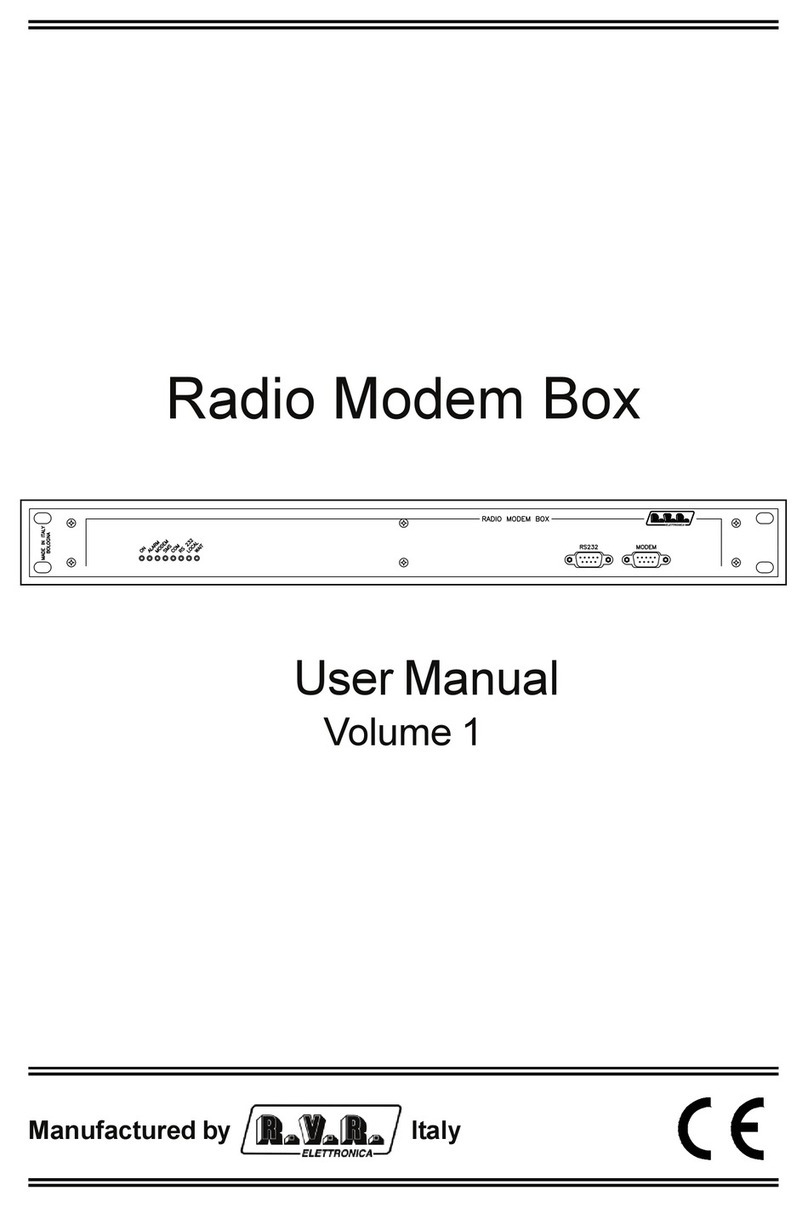
R.V.R. Electronica
R.V.R. Electronica Radio Modem Box user manual
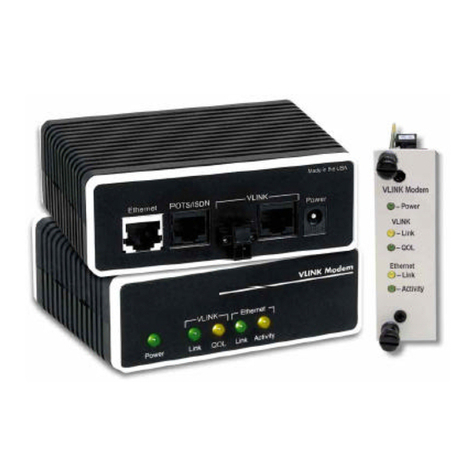
Black Box
Black Box ME0010A-VDSL user manual

Air-Bus
Air-Bus TW1m instruction manual
